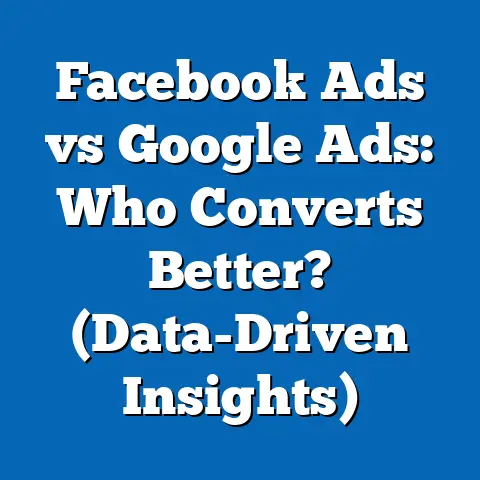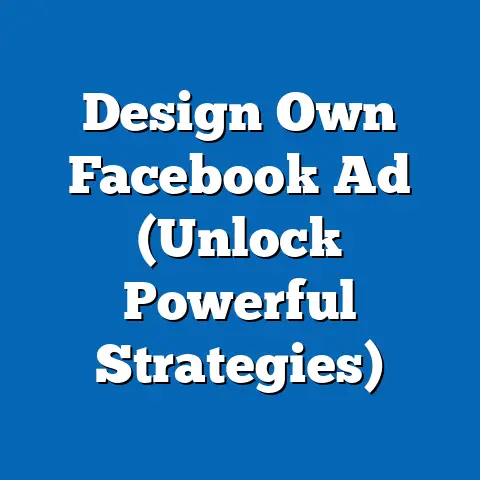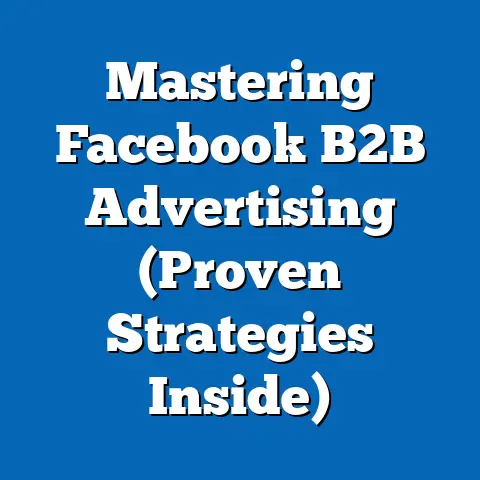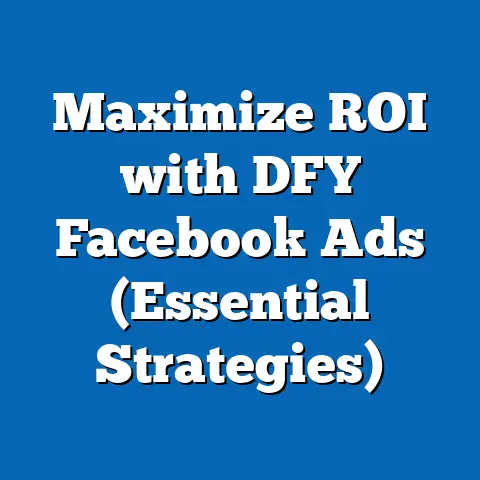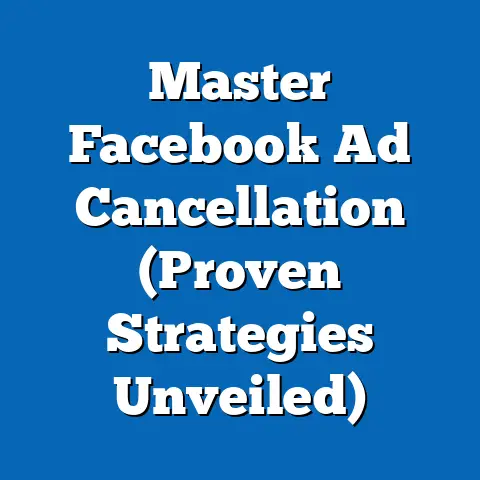Bikini Ads on Facebook: (Explore Effective Guidelines)
Think about it: you’re trying to showcase your beautiful bikini designs, but Facebook’s algorithms are constantly scanning for content that could be considered sexually suggestive or inappropriate. It’s a delicate dance, and one wrong step can lead to your ads being rejected, your account being suspended, or even worse, a PR nightmare if your ads are perceived as offensive. In fact, I’ve seen small businesses lose significant revenue due to ad account suspensions stemming from misunderstood or ignored policies. The good news? With a little knowledge and careful planning, you can create bikini ads that not only look great but also drive sales without running afoul of Facebook’s rules.
Understanding Facebook’s Advertising Policies
Facebook’s advertising policies are the bedrock of any successful campaign, especially when it comes to sensitive topics like swimwear. I’ve spent countless hours poring over these policies, and I can tell you, they’re not always as straightforward as you might think. The key is to understand the spirit of the rules, not just the letter.
Specifically, when it comes to apparel and swimwear, you need to be hyper-aware of the following:
- Nudity and Sexual Content: This is the big one. Obviously, outright nudity is a no-go. But even suggestive poses or close-ups that overly emphasize certain body parts can trigger the algorithms. Think about it this way: would you be comfortable showing this ad to your grandmother? If the answer is even a hesitant “maybe,” it’s probably too risky.
- Body Image and “Perfect Body” Claims: Facebook is increasingly cracking down on ads that promote unrealistic or unhealthy body images. Ads that explicitly or implicitly suggest that people need to change their bodies to be attractive or desirable are likely to be rejected. Avoid phrases like “get your beach body ready” or images that are heavily Photoshopped to create an unattainable ideal.
- Exploitation: This policy prohibits content that exploits, endangers, or otherwise puts children at risk. This is particularly relevant if you’re advertising swimwear for children or using child models in your ads.
Real-World Example:
I once worked with a swimwear brand that had a stunning photoshoot featuring models in their latest collection. The photos were beautiful, but several ads were rejected because they featured close-ups of the models’ backsides, even though the models were fully clothed in bikinis. Facebook’s algorithm flagged these images as potentially sexually suggestive. The lesson learned? Always err on the side of caution when choosing your visuals.
Recent Policy Changes:
Facebook is constantly updating its policies, so it’s crucial to stay informed. Recently, I’ve noticed a stricter enforcement of the “body image” policy, with ads being rejected for even subtle suggestions of body shaming or unrealistic beauty standards. Make sure to regularly review Facebook’s advertising policies page and pay attention to any announcements or updates related to apparel and swimwear.
Takeaway: Thoroughly familiarize yourself with Facebook’s advertising policies, especially those related to nudity, sexual content, and body image. Stay updated on any policy changes and err on the side of caution when creating your ads.
Target Audience Identification
Knowing your audience is paramount. I’ve seen campaigns fail spectacularly simply because they were targeting the wrong people. It’s like trying to sell snow to Eskimos – you might have a great product, but if no one needs it, you’re wasting your time and money.
When it comes to bikini ads, your target audience could be incredibly diverse, ranging from young women looking for trendy swimwear to older women seeking comfortable and supportive options. Understanding their demographics, interests, and behaviors is crucial for creating ads that resonate with them.
Here’s a breakdown of key audience considerations:
- Age: Are you targeting teenagers, young adults, or mature women? Each age group has different preferences and priorities when it comes to swimwear.
- Gender: While bikinis are primarily marketed towards women, don’t rule out the possibility of targeting men who might be buying swimwear as gifts.
- Interests: What are your target audience’s hobbies and interests? Do they enjoy surfing, swimming, sunbathing, or traveling to tropical destinations?
- Behaviors: What are their online shopping habits? Are they frequent online shoppers, or do they prefer to shop in brick-and-mortar stores? Are they active on social media, and if so, which platforms do they use the most?
Using Facebook’s Tools for Audience Research:
Facebook offers a wealth of tools for conducting audience research, including:
- Facebook Audience Insights: This tool allows you to analyze the demographics, interests, and behaviors of people who are connected to your Facebook page or who are part of a custom audience.
- Facebook Pixel: By installing the Facebook Pixel on your website, you can track the actions that people take on your site, such as viewing products, adding items to their cart, or making a purchase. This data can be used to create custom audiences based on website behavior.
- Lookalike Audiences: Once you’ve created a custom audience, you can use Facebook’s lookalike audience feature to find people who are similar to your existing customers.
Example:
Let’s say you’re selling eco-friendly bikinis made from recycled materials. Your target audience might be women aged 25-45 who are interested in sustainable fashion, environmentalism, and outdoor activities. You could use Facebook Audience Insights to identify people who have liked pages related to these topics, and then create a custom audience based on this data.
Takeaway: Invest time in identifying and understanding your target audience. Use Facebook’s tools to conduct audience research and create highly targeted ad campaigns. A well-defined target audience can significantly improve your ad performance and reduce the risk of rejection.
Crafting Compelling Ad Copy
The words you use in your ad copy are just as important as the visuals. I’ve seen ads with stunning images fall flat because the copy was bland, generic, or, worse, offensive. Your ad copy needs to be clear, concise, and persuasive, while also adhering to Facebook’s guidelines.
Here are some tips for writing effective ad copy for bikini products:
- Highlight the Benefits, Not Just the Features: Instead of simply listing the features of your bikini (e.g., “made from nylon and spandex”), focus on the benefits (e.g., “comfortable, quick-drying, and perfect for swimming”).
- Use Strong Action Verbs: Encourage people to take action by using strong action verbs like “shop now,” “discover,” “explore,” or “get yours today.”
- Create a Sense of Urgency: Limited-time offers or exclusive discounts can incentivize people to make a purchase. Use phrases like “limited stock available” or “sale ends soon” to create a sense of urgency.
- Speak to Your Target Audience: Use language that resonates with your target audience. If you’re targeting young women, you might use more casual and trendy language. If you’re targeting mature women, you might use more sophisticated and elegant language.
- Avoid Making False or Misleading Claims: Be honest and transparent about your product. Avoid making claims that are not supported by evidence or that could be considered misleading.
Example of Successful Bikini Ad Copy:
“☀️ Soak up the sun in our new collection of eco-friendly bikinis! Made from recycled materials, our bikinis are not only stylish but also good for the planet. Shop now and get 20% off your first order! Limited stock available. #ecofriendlyfashion #sustainable swimwear #bikini”
Analyzing What Makes This Ad Effective:
- Clear and Concise: The ad copy is easy to understand and gets straight to the point.
- Highlights the Benefits: It emphasizes the benefits of the bikini (stylish and eco-friendly) rather than just the features.
- Uses a Strong Call to Action: It encourages people to “shop now” and take advantage of a discount.
- Creates a Sense of Urgency: It mentions that stock is limited, which encourages people to act quickly.
- Uses Relevant Hashtags: It uses relevant hashtags to reach a wider audience.
Staying Compliant with Facebook’s Guidelines:
Remember to avoid language that could be considered sexually suggestive or that promotes unrealistic body images. Steer clear of phrases like “get your beach body ready” or “look your best in our bikinis.” Instead, focus on the comfort, style, and quality of your product.
Takeaway: Craft compelling ad copy that highlights the benefits of your bikini products while remaining compliant with Facebook’s guidelines. Use clear, concise, and persuasive language that resonates with your target audience.
Visual Content Best Practices
In the world of Facebook advertising, visuals reign supreme. I’ve always said that a picture is worth a thousand words, and that’s especially true when you’re trying to sell something as visually driven as swimwear. However, as we’ve discussed, the visuals you use in your bikini ads need to be carefully chosen to avoid violating Facebook’s policies.
Here are some best practices for creating eye-catching imagery that adheres to Facebook’s guidelines:
- Focus on the Product, Not Just the Model: Make sure your photos showcase the bikini itself, not just the model wearing it. Use a variety of angles and close-ups to highlight the details of the design.
- Choose Appropriate Poses: Avoid poses that are overly suggestive or that focus on certain body parts. Opt for natural and relaxed poses that showcase the model’s personality and confidence.
- Use High-Quality Images: Blurry or pixelated images will turn people off. Use high-resolution photos that are well-lit and professionally edited.
- Consider the Background: Choose a background that complements the bikini and enhances the overall aesthetic of the image. A beach setting is a classic choice, but you could also use a pool, a garden, or even a studio backdrop.
- Be Mindful of Diversity: Feature models of different ages, sizes, and ethnicities to appeal to a wider audience.
Example:
Instead of a close-up shot of a model’s cleavage, use a wide shot that shows the model enjoying herself on the beach while wearing your bikini. This type of image is more likely to be approved by Facebook and is also more likely to resonate with your target audience.
Case Study:
A swimwear brand called “Body Positive Swim” has successfully navigated the challenges of advertising bikini products on Facebook by featuring models of all shapes and sizes in their ads. Their images are inclusive, empowering, and body-positive, and they have built a loyal following as a result.
Practical Tips for Photography, Design, and Editing:
- Use Natural Lighting: Natural lighting is always the best option for swimwear photography. Shoot outdoors during the golden hour (the hour after sunrise and the hour before sunset) for the most flattering light.
- Hire a Professional Photographer: If you’re serious about creating high-quality images, it’s worth investing in a professional photographer who has experience shooting swimwear.
- Use Photo Editing Software: Photo editing software like Adobe Photoshop or Lightroom can help you enhance your images and correct any imperfections. However, be careful not to over-edit your photos, as this can make them look unnatural.
Takeaway: Create eye-catching imagery that showcases your bikini products in an appealing yet compliant manner. Focus on the product, choose appropriate poses, use high-quality images, and be mindful of diversity.
Testing and Analyzing Ad Performance
Creating a great ad is only half the battle. The other half is testing, analyzing, and optimizing your ads to ensure they’re performing as well as possible. I’ve seen countless businesses launch campaigns and then simply sit back and wait for the results, without ever bothering to check if their ads are actually working. That’s a recipe for disaster.
Here’s why testing and analyzing ad performance is so important:
- It Helps You Identify What Works and What Doesn’t: By testing different ad variations, you can see which ones resonate with your target audience and which ones don’t.
- It Allows You to Optimize Your Campaigns: By analyzing your ad performance metrics, you can identify areas where you can improve your campaigns, such as your targeting, your ad copy, or your visuals.
- It Helps You Maximize Your ROI: By optimizing your campaigns, you can get more bang for your buck and achieve a higher return on investment.
A/B Testing:
A/B testing involves creating two or more versions of an ad and then running them simultaneously to see which one performs better. You can test different elements of your ad, such as your headline, your body copy, your image, or your call to action.
Setting Up Tests for Different Ad Variations:
Facebook’s Ads Manager makes it easy to set up A/B tests. Simply create two or more ad sets with different ad variations and then let Facebook run them simultaneously. Facebook will automatically track the performance of each ad variation and tell you which one is performing better.
Tracking Performance:
Here are some key performance indicators (KPIs) that you should focus on when analyzing your ad performance:
- Click-Through Rate (CTR): The percentage of people who see your ad and click on it. A high CTR indicates that your ad is relevant and engaging to your target audience.
- Conversion Rate: The percentage of people who click on your ad and then take a desired action, such as making a purchase or signing up for your email list. A high conversion rate indicates that your ad is effectively driving results.
- Cost Per Click (CPC): The amount you pay each time someone clicks on your ad. A low CPC indicates that your ad is cost-effective.
- Cost Per Acquisition (CPA): The amount you pay each time someone takes a desired action, such as making a purchase or signing up for your email list. A low CPA indicates that your ad is efficiently driving results.
- Engagement Metrics: Likes, comments, shares, and other forms of engagement can indicate how well your ad is resonating with your target audience.
Using Data to Optimize Future Campaigns:
Once you’ve gathered enough data, you can use it to optimize your future campaigns. For example, if you find that ads with a certain headline or image perform better than others, you can use that information to create more effective ads in the future.
Takeaway: Continuously test and analyze your ad campaigns to identify what works and what doesn’t. Use data to optimize your campaigns and maximize your ROI. A/B testing and careful tracking of KPIs are essential for success.
Conclusion
Advertising bikini products on Facebook can be a rewarding endeavor, but it requires a careful balance of creativity, compliance, and data-driven decision-making. Throughout this guide, I’ve emphasized the importance of understanding Facebook’s advertising policies, identifying the right audience, crafting compelling ad copy, using effective visuals, and continuously testing and analyzing your ad campaigns.
I’ve seen firsthand how businesses that follow these guidelines can achieve significant success on Facebook, driving sales, building brand awareness, and connecting with their target audience. On the other hand, I’ve also seen businesses that ignore these guidelines struggle to get their ads approved, waste their ad spend, and even damage their brand reputation.
Remember, Facebook’s advertising policies are constantly evolving, so it’s crucial to stay informed and adapt your strategies accordingly. By staying up-to-date on the latest best practices and continuously testing and optimizing your campaigns, you can navigate the challenges of advertising in the bikini niche effectively and achieve your marketing goals.
So, go forth and create stunning, compliant, and high-performing bikini ads on Facebook! With the knowledge and tools you’ve gained from this guide, you’re well-equipped to succeed. Don’t be afraid to experiment, learn from your mistakes, and continuously strive to improve your campaigns. The world of Facebook advertising is constantly changing, but with a proactive and data-driven approach, you can stay ahead of the curve and achieve lasting success.

